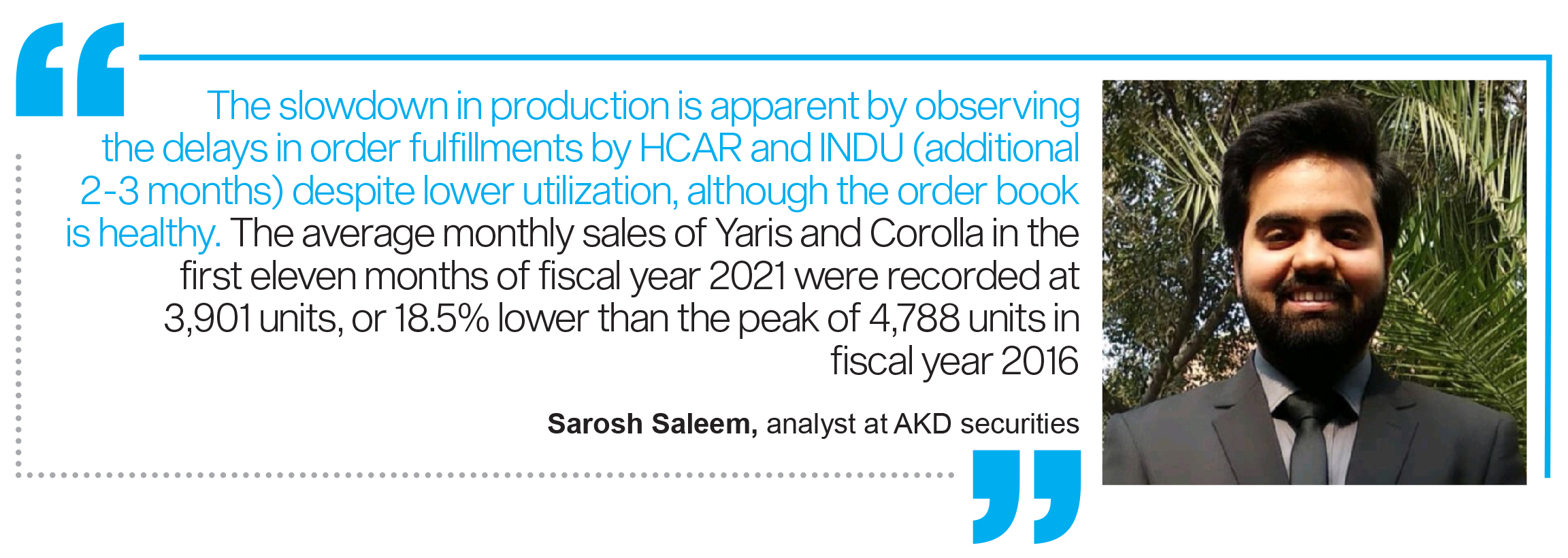The first commercially available semiconductor chip in the world was manufactured in 1971, by Intel (a company which itself had only been created a few years prior, in 1968). Since then, demand for the chip has exploded – as the world discovered new ways to use the chip: computers, medical appliances, gaming devices, and yes cars.
There’s only one problem: there’s a global shortage of the chips, and that’s having a ramification on major automobile companies. And as Saraosh Saleem, analyst at AKD Securities pointed out in a note sent to clients on June 17, that also has ramifications on Pakistan.
But first: why is there a shortage? It turns out, it is notoriously difficult to create a semiconductor chip. A recent graphic article in Bloomberg pointed out several design hurdles: to create a semiconductor chip, there has to be essentially no dust in a room, which means that there are very few humans (and they are usually covered in head to toe protective equipment). Instead, factories involve robots as much as possible. To create a semiconductor requires at least 57 different types of specialized equipment. No wonder then, that the average costs of an entry level factory is $15 billion. There are three global companies – Intel (in the United States), Samsung (Korean) and TSMC (Taiwan) that account for most of the world’s sales of chips. These three companies are able to dominate because they have already made the requisite large investments (remember, Intel has been around since 1968). A typical factory for these three costs $20 billion.
The absurdly high and prohibitive costs mena that it is actually very hard for new players to enter the market. And that constricts the supply of manufacturers. The only problem is the demand for semiconductor chips has boomed – particularly in cars. As an example chips are used in vehicle electrification, safety and driver assistance, connectivity, switching, amplification and energy conversion.

The shortage was inevitable, but Covid-19 made it worse. The pandemic meant a surge in sales of electronic devices, as everyone stayed home, and also a snowballing of electronic content in cars. To top it off, Taiwan, which supplies two-thirds of semiconductor chips globally, received 60% less than the average annual rainfall so far in 2021, causing reservoir levels to drop. There just isn’t enough water in Taiwan, which is a problem, because the semiconductor industry requires huge amounts of very pure water for cleaning at each stage of manufacturing.
All of this to say that the prices of semiconductors have shot up – by 20.3% in 2020. In fact, the entire industry grew by 10.8% year-on-year to $464 billion. And the trend is set to continue: the prices in 2021 are expected to remain on the higher side, and the industry is expected to increase by 12.5% to $522 billion.
The price surge and shortage have caused a disruption in supply chains around the world, impacting the production of global automobile companies like Ford, Volkswagen Jaguar and Land Rover. According to Saleem, the global shortage has had a trickle-down effect on the production of the local auto industry, causing a slowdown especially in the luxury SUV and 1300CC+ sedan segment in which the use of semiconductors chips is higher.
“The slowdown in production is apparent by observing the delays in order fulfillments by HCAR and INDU (additional 2-3 months) despite lower utilization, although the order book is healthy,” explained Saleem. According to him, the average monthly sales of Yaris and Corolla in the first eleven months of fiscal year 2021 were recorded at 3,901 units, or 18.5% lower than the peak of 4,788 units in fiscal year 2016.
Meanwhile, the average monthly sales of Civic and City is 2,040 units during the same period, compared to the peak of 3,568 units in fiscal year 2018, or a drop by 43%. Tangentially, there has also been a rise in prices for cold rolled steel and hot rolled steel, which has increased the cost of production for local manufacturers.
According to Saleem, the supply of chips will remain under pressure till the end of 2021, but the slowdown in production will last well into fiscal year 2022. “Assuming the avg. price and margins to remain constant in FY22, an assumption of 5% decline in volume of INDU will result in a decline in EPS by PkR7.6, from PkR156.6 to PkR149,” Saleem predicts.
He pointed out the 1300CC+ segment as one to watch out for, as the new Honda City and new Toyota Corolla which are expected to release in 2022, will support sales momentum in the long run. Additionally, he was optimistic on Pak Suzuki, mostly because its small cars simply don’t have as much electronic content, and therefore will not be as impacted as other companies.
























